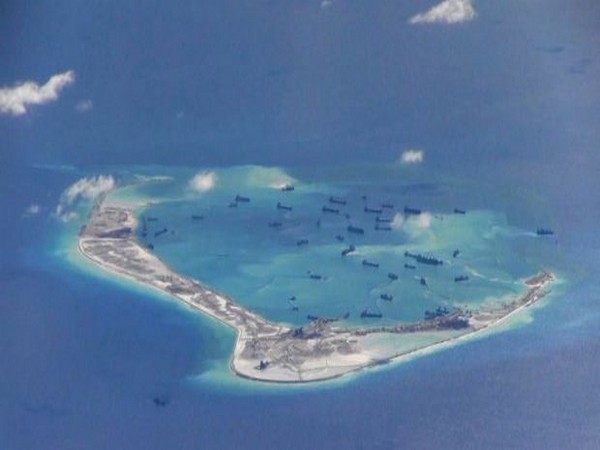
Do Beijing’s artificial islands in South China Sea represent an asset to its military?

Beijing [China], June 28 (ANI): China has conducted a land reclamation project under which it is building artificial islands in the South China Sea, but do they really represent an asset to China’s military?
China has established numerous military installations in the artificial islands of the South China Sea (SCS), primarily in the Spratly and Paracel Islands, reported The National Interest.
In the Spratlys, China has built airfields at Subi, Mischief and Fiery Cross, along with potential missile, radar and helicopter infrastructure at several smaller formations.
In the Paracels, China has established a significant military installation at Woody Island, as well as radar and helicopter facilities in several other areas.
China continues construction across the region, meaning that it may expand its military presence in the future, said Robert Farley, in an article of The National Interest.
The larger bases (Subi, Mischief, Fiery Cross and Woody Island) have the infrastructure necessary for the management of military aircraft, including fighters and large patrol craft. These missiles, radars and aircraft extend the lethal reach of China’s military across the breadth of the South China Sea, reported The National Interest.
As per Farley the islands of the SCS are conveniently located for China and represent an asset to China’s military but in an actual conflict, the value would dwindle quickly.
Militarily, the islands represent a thin crust on China’s A2/AD system. The anti-access/area denial (A2/AD) strategy aims at keeping out US military intervention in its immediate areas of concern, including the disputed waters in the region.
Several of the islands serve as bases for Surface-to-Air Missile (SAM) systems (including the HQ-9, with a range of 125 miles, and perhaps eventually the Russian S-400) and ground-launched cruise missiles (GLCMs).
But it is an open question how survivable is the missile installations in a conflict. Land-based missiles survive air attacks because they can hide among hills, forests and other natural covers. There is no effective natural cover on the islands that China has created, and even man-made defensive installations may not survive the concerted attack, said Farley.
The four largest military installations in the SCS have extensive facilities for the operation of military aircraft. This includes advanced fighters, but more importantly patrol, electronic warfare and advanced early-warning aircraft. The ability to use these airfields effectively extends the reach of China’s A2/AD bubble, enabling the transmission of targeting data to missile launchers at sea and in mainland China.
But in conflict, the durability of an airfield depends on the availability of materials and equipment to execute repairs after an attack. It is not obvious that the islands China has created in the South China Sea will be robust enough to continue in operation after U.S. missile and bomb attacks, said Farley.
SAMs, GLCMs and combat aircraft depend on accurate targeting data for effectiveness. The most important contribution that the SCS islands may offer to the Chinese military is through the radar installations that China has established on many of the islands. These installations, while individually vulnerable, help to provide a much fuller picture of the battlespace than China would otherwise enjoy, reported The National Interest.
But, the radars themselves are vulnerable to a wide array of US attacks. These include kinetic methods such as missiles (launched from submarines, stealth aircraft or other platforms), electronic warfare, cyber-attacks and even special-forces raids.
In a conflict, China could quickly lose access to the radar network that it has established. Still, the network offers a relatively low-cost way of complicating the job that the US military faces in penetrating the SCS, said Farley.
All the military capabilities of China’s SCS islands depend upon secure communications with mainland China. Most of the islands constructed by China cannot support extensive logistics stockpiles or keep those stockpiles safe from attack.
Unfortunately for China, the very nature of island warfare, and the nature of the specific formations that China has determined to support, makes it difficult to keep installations in service in anything but the very short term, said Farley.
As Lord Horatio Nelson may have quipped, “a ship’s a fool to fight a fort.” But there are situations in which ships have a major advantage over forts. China’s islands in the SCS are not mobile and are not large enough to hide much in the way of military equipment and material.
The United States will be able to meticulously map the military installations on each of the islands in the SCS, and will probably be able to track shipments of military equipment to the islands, reported The National Interest.
This will make the islands extremely vulnerable to attack from ships, subs and aircraft, as missiles will not require real-time targeting data.
The islands of the SCS have some military relevance but are more important as a political claim to waterways and undersea resources. Militarily, they represent a thin crust on China’s A2/AD system.
Under certain conditions, this crust could disrupt US freedom of action, but it won’t be hard for the United States Air Force and Navy to punch through, reported The National Interest.
During World War II Japan found that control of islands offered some strategic advantages, but not enough to force the United States to reduce each island individually.
Moreover, over time the islands became a strategic liability, as Japan struggled to keep them supplied with food, fuel and equipment. (ANI)

















POST COMMENTS (0)